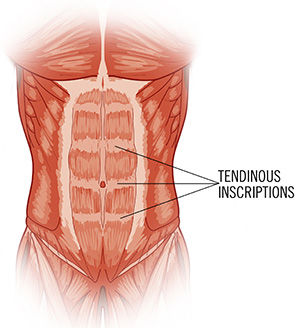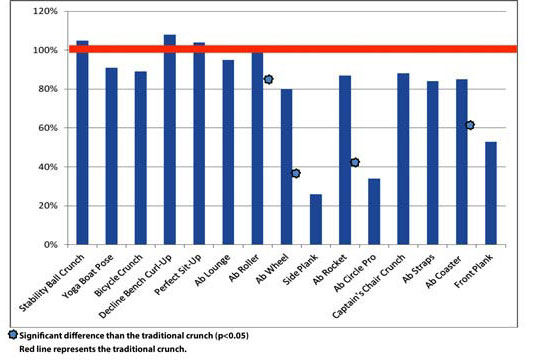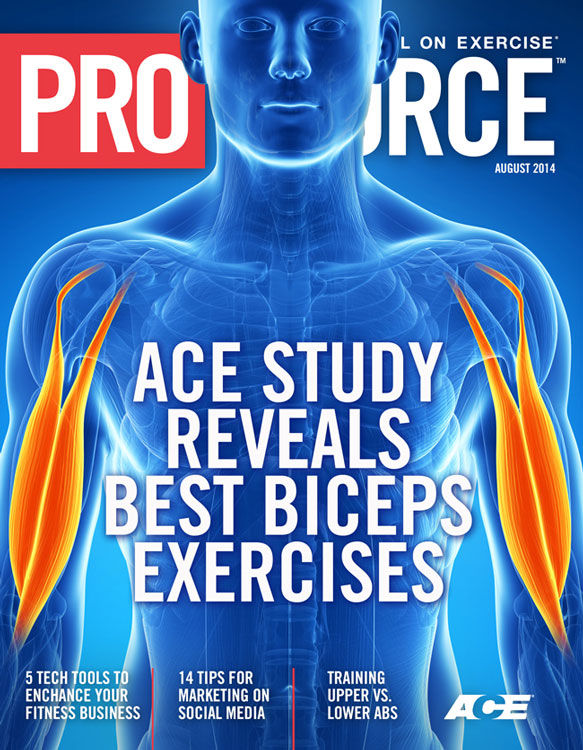
Arguably, there are more erroneous beliefs, myths and misconceptions about working the abdominals than just about any other muscle in the body. And this is largely true for both the general public and the fitness industry. Part of the difficulty is our desire for neat, clean, absolute answers in black and white. Unfortunately, as is the case with so many aspects of life, reality usually comes in shades of gray.
One of the more confusing and controversial topics in the fitness world is the question of whether or not there is any difference between the upper and lower abs. Before we start examining what the research says, consider this: When you’re informed, you make better choices and decisions, especially when there is often no one absolute correct choice to make. A thoughtful approach to training will rarely lead you astray even if it cannot deliver one “perfect” approach.
In that spirit, let’s take a look at a couple of recent studies that will help clarify how to choose exercises to strengthen the entire abdominal region. We’ll also attempt to answer the question of whether or not it really matters if the upper and lower abs are treated as a single entity or separate muscles.
Keep these definitions in mind as you read on:
URA = Upper Rectus Abdominis
LRA = Lower Rectus Abdominis
RA = Rectus Abdominis
Here’s What You Need to Know (The Short Version)
•One study comparing muscular activity of the URA and LRA found no significant difference between the two using five isometric body-weight exercises.
•An ACE-commissioned study comparing many popular exercises and many popular pieces of abdominal training equipment found that the crunch is the winner in terms of highest RA activation.
•Be careful of a false distinction we create when discussing the ability to selectively contract the URA and LRA.
•Nature doesn’t like waste.
•Exercise choice and program design will always and forever be highly dependent upon an individual’s goals and abilities.
Here’s What You Need to Know (The Extended Version)
What happens when we study the contractile difference between the upper and lower abs? That’s what Lehman and McGill did in a study published in Physical Therapy. In looking at muscle activity between the URA and LRA during five different exercises (the isometric portion of curl-ups, abdominal muscle lifts, leg raises, and restricted or attempted leg raises and curl-ups.), they found no statistically significant difference between URA and LRA activity. So, from this study, it would seem that the debate is settled.
But first, we need to look at another study.
An ACE-commissioned study published last year compared the relative amount of muscle activity in the RA while performing the crunch versus a few other common body-weight exercises and those performed with several pieces of abdominal training equipment. (Specifically, researchers compared the crunch to the Ab Circle Pro, Ab Roller, Ab Lounge, Perfect Sit-Up, Ab Coaster, Ab Rocket, Ab Wheel and Ab Straps, and to seven exercises: yoga boat pose, stability ball crunch, decline bench curl-up, captain’s chair crunch, bicycle crunch, side plank and front plank.) No other exercise showed higher activity in the RA relative to the crunch. Interestingly, in this study, the researchers chose to measure the URA and LRA separately during the performance of each of the exercises.
Thought Bubble
At this point, you are probably starting to whisper “So what?” silently to yourself. Let’s discuss the studies and see if there are any practical insights that can help you effectively train your client tomorrow morning without your head exploding from uncertainty.
It is essential to let you know that I will typically take the approach of recommending what works for most people. There are always outliers and anecdotes about single individuals who smoke and booze it up and live to be a hundred. If you are in a position of making recommendations to the public (which we both are), anecdotes about extreme circumstances are mostly useless.
Here’s where we are so far: We have a study that shows no difference between the URA and LRA and another one that says the crunch is king for RA activity. Wait…what?
It’s become trendy to punch on the crunch, but the criticism is, in my opinion, overheated. I believe many people find comfort in having something to vilify as the one and only source of all difficulty whenever anything is difficult. I’m not a huge fan of the crunch, but the vehement antagonism of crunches across the board is unwarranted. It’s probably due to our industry’s frustration with the public’s long-term obsession with crunches. Our frustration leads us to make overblown conclusions about the dangers of the crunch as an exercise based on rather large extrapolations from research and leaps in logic. However, the reality is that the danger often comes down to poor technique and/or too much of the exercise combined with the fact that it simply may not be a wise choice for people with lumbar spine pathology.
My advice to the fitness industry? Relax. A properly performed crunch done at a reasonable volume will not make people’s lumbar spines catch on fire. And depending on your client’s health history and training goals, it may or may not be an appropriate choice of exercise. This last point is often the determining factor in whether or not using a crunch is wise.
With that out of the way, let’s investigate some more of the details in the two studies above and crank out some practical goodness you can use.
In the first study, researchers made an interesting choice in the technique used in the exercises. They had the participants keep their hands under the lower back. Their rationale is that it would result in a mechanical stop that would not allow the lower back to round out (press flat to the floor) during all of the exercises, which was their attempt to maintain the same spinal curvature in all conditions. It is significant to note that the aim of the study was to measure isometric muscle action, and that is a wise choice if that is the goal. This may also lead to less ability of many of the LRA fibers to act, because they would essentially have to pull “uphill” on the hips, even if there were no change in length. The URA fibers would have a better mechanical advantage to fire during these exercises. Perhaps the fact that isometric exercises were used (when most of what people are concerned with is non-isometric exercise), it is possible the design of the study limited some of what can be concluded about the relative activity.
Interestingly, I think we may be asking the wrong question over and over. The problem lies in studying whether we can “selectively contract” the URA and LRA. Why do we insist on looking for high levels of muscle activity in one area and expecting the near absence of it in the other area? I think it is far more interesting to consider why there are those tendinous inscriptions cross-cutting the abdominals that create the six-pack look.

One thing I always try to remember is the concept that biology doesn’t like waste. Why are there tendinous inscriptions that essentially “bolt” the RA muscle down to the abdominal wall? We don’t have these running across our biceps or hamstrings. Why are they there? Even though the entire RA muscle will fire when it is activated, the inscriptions allow an even distribution of force across the muscle—and this is true even though more work is being done by either the URA or the LRA on a given exercise. In the reverse crunch, for example, the LRA moves through a greater distance than the URA, so it makes sense that we experience more fatigue there.
Another thing to consider: We don’t often debate the possibility of contracting the upper hamstrings vs. the lower hamstrings. We understand—and expect—that the entire muscle is active. But don’t we feel more fatigue in the belly of the muscle on a hamstring curl and more fatigue higher up in the hamstring near the hips when performing a straight-leg deadlift? These are two distinct movements, so why would we expect to experience them the same way in a muscle, even when that muscle is active in both exercises? That’s a lot of questions. Most of them were rhetorical to help stimulate your thinking to come up with the best response for you, who you train and how you train. A thoughtful approach will never be wrong, even if it may not be absolutely 100 percent “right.”
Remember, reality is rarely available in black or white.
Countless times over the years, both in performing exercises personally and also leading exercise professionally, there has been a clear experience of greater fatigue in the URA or LRA fibers depending on the exercise performed. When I perform a crunch, I feel more fatigue in the upper fibers. When I perform a reverse crunch, I feel more fatigue in the lower fibers. And it’s not just me. Just about everyone I’ve ever trained has reported the same feeling.
As mentioned earlier, our problem lies in examining whether separately contracting the URA and LRA is possible, even though examining the relative contraction between the URA and LRA might prove to be more effective. Research likes to isolate variables, which isn’t easy (if not impossible) to do when studying movement in living creatures.
And this brings us to the second study. As mentioned previously, in the ACE-commissioned study, the researchers measured URA and LRA activity separately even though that was not the primary point of the study. And if you look at the URA and LRA activity for each of the exercises (measured relative to the crunch, keep in mind), there is a noticeable (but not massive) difference in URA and LRA activity in each exercise (Figures 1 and 2).
Figure 1. Comparison of upper rectus abdominis (URA) activation for the various exercises compared to the traditional crunch.

Figure 2. Comparison of lower rectus abdominis (LRA) activation for the various exercises compared to the traditional crunch.

However, this second study does raise another interesting question. It showed that the crunch is the winner in terms of highest amount of RA activity. Is this a good thing? In life, the abs function in conjunction with each other and the rest of the body. This is precisely why many of the other exercises—even the stability ball crunch—showed less RA activity relative to the crunch. The nature of the exercise or equipment was such that the load was spread out across more of the body’s musculature. In choosing exercises that feature more total-body instability (initiating a reflexive response of many other muscles to stabilize the body), it is really no surprise to find that when measuring RA activity, the crunch is the clear winner.
So What Do You Do?
As usual, the correct answer to this question requires you to first consider who you are training, what their goals are, what their injury status is and their ability to correctly perform exercises. If your client’s goal is to achieve well-defined abdominals, then nutrition is probably the most important factor as the body has a “first in, last out” approach when it comes to storing and losing subcutaneous body fat. Additionally, most people with this type of goal would benefit from performing direct ab training because this is the best way to hypertrophy any muscle in the body. Lowering body fat and raising muscle is a winning combination.
For those whose goals are more about function, performance or even posture, they may not need direct, isolated ab training at all. Instead, they may be better served by full-body core exercises that use many abdominal muscles working together to create effective, coordinated movement.
We all look like an anatomy chart under our skin and body fat, so hitting the abs hard and directly with exercises that feature a high amount of RA activity may be appropriate only for those individuals who have appearance-oriented goals and an injury-free spinal history.
And as for those upper and lower abs? They don’t really exist in the lab, but empirically you can feel one region working harder than the other during certain exercises. In general, if the hips move closer to the ribs with the ribs held fixed, the LRA will perform more work (work = force x distance), and so the user will experience the sensation of fatigue. Likewise, if the ribs move closer to fixed hips, the URA will perform more work.
Last Reps
So it’s “settled” then. There is no real distinction between the URA and LRA in the lab, but there seems to be some when you perform certain exercises. Just remember: EMG activity doesn’t measure the amount of work that is performed. You can get lots of EMG activity on an isometric exercise…all while performing zero work.
Bottom line: Choose exercises based on your clients' goals, current health history and ability to perform exercises correctly. With smart program design from you, they will have abdominal muscles that perform well. If they also want abdominals that look great, they may need a little additional direct ab work and some heightened awareness regarding their nutrition.





 by
by 





